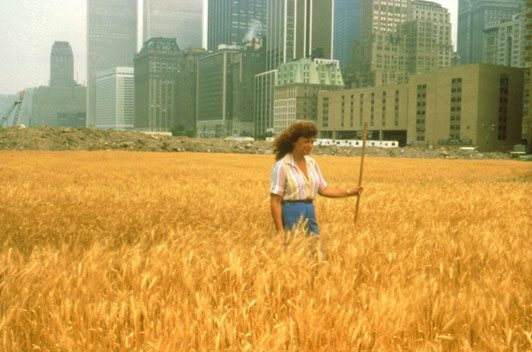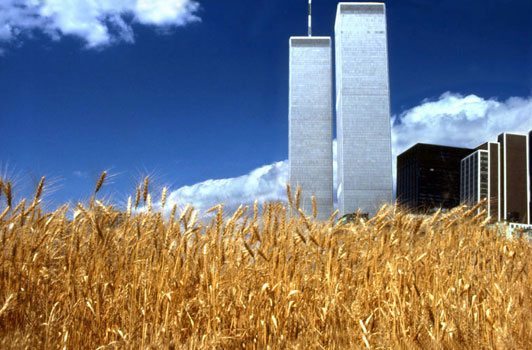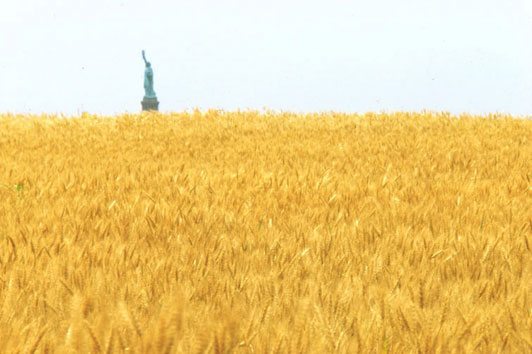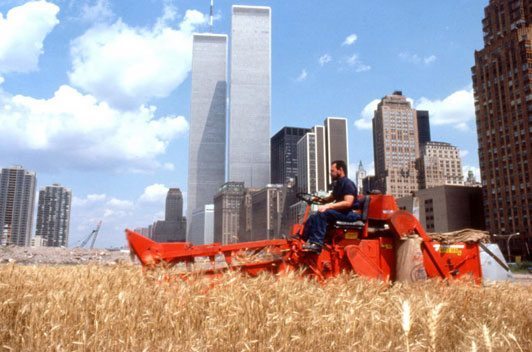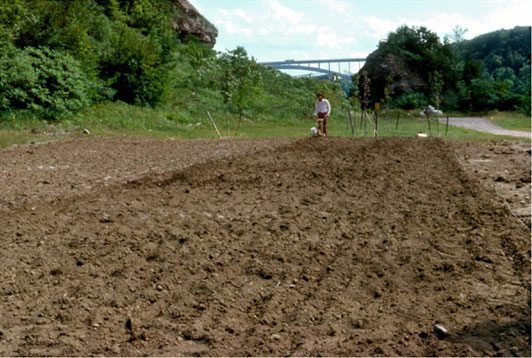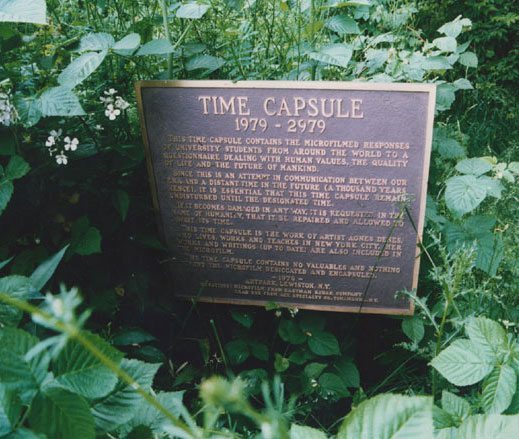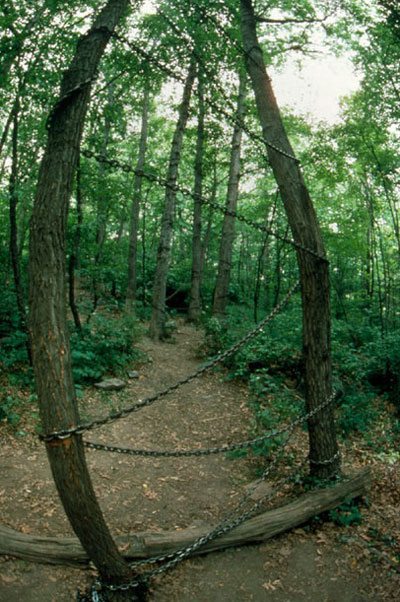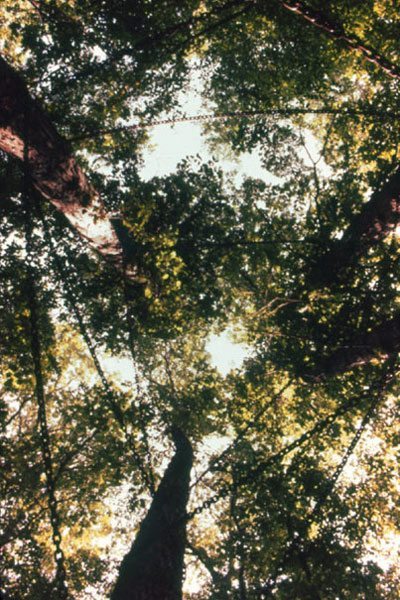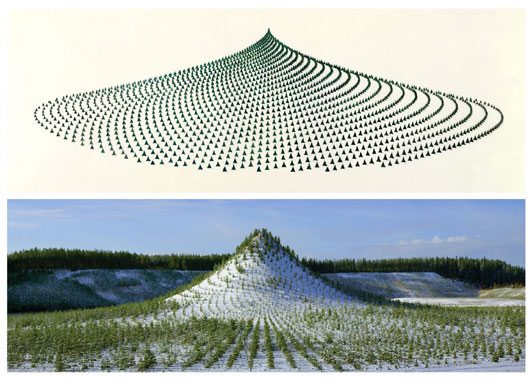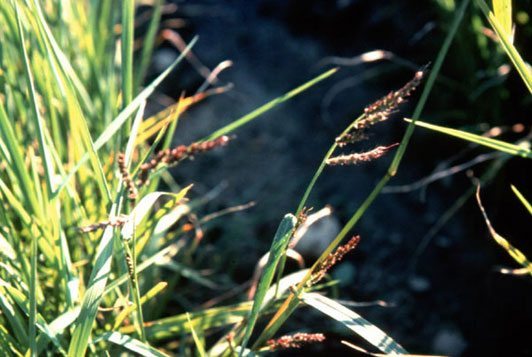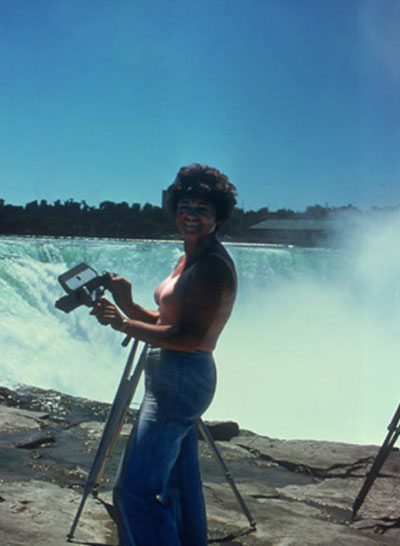In This Issue
-
Beth Carruthers ● Canada: Ecoart Terrain, Part II
-
Raleheh Zomorodinia and Mahmoud Maktabi ● Iran: A Growing Eco Art Movement
-
Jean Grant ● England: ‘pool Project
-
Claudia Bernardi ● El Salvador & Colombia: Walls of Hope
-
Insa Winkler ● Germany: Bodies & Ingredients Of Life
-
Joyce Cutler-Shaw ● The Rio Grande: Water & Collaboration
-
Susan Leibovitz Steinman ● GLOBAL IS PERSONAL
-
Agnes Denes ● Art For The Third Millennium, Creating A New World
-
Anke Mellin ● S. Korea: Geumgang Nature Art Biennale
-
Betsy Damon ● Journeys and Visions
Art For The Third Millennium, Creating A New World
I STARTED OUT AS A POET BUT gave up poetry for the visual expression when I lost my language.
I realized that art had to change in a world drastically changing, when humanity was facing major decisions in order to survive on the planet while striving to maintain moral values and quality of life. I wanted to cleanse art from its elitist self-involvement, to achieve greater universal validity. I left the ivory tower of my studio and entered the world of concerns. I wrote books, spoke at global conferences and began to create large scale environmental projects I called Philosophy in the Land. I created Rice/Tree/Burial, the first large scale ecological site work in 1968 with these concerns in mind.
These works probed ecological, cultural, and social issues; explored the paradoxes of human existence, and addressed global survival. I began by visualizing invisible process such as logic, thought processes, evolution, time, music, and mathematics. Some of these works became the building blocks for my pyramids, expressions of social philosophy: an investigation of what it means to be human. The early Philosophical Drawings took me into the sciences, technology, dialectics, symbolic logic, theology, time, truth functions. I was beginning to unite disciplines alienated through specialization, and came to look at art as an integrator of disciplines and the role of the artist as developing a new vision for humanity.
I believe that the new role of the artist is to create an art that questions the status quo and the direction life has taken, the endless contradictions we accept and approve, offering intelligent alternatives
The issues touched on in my work range between individual creation and social consciousness. They address the challenges of global survival and are often monumental in scale.
I plant forests on abused land to be kept alive for centuries and fields of grain in the heart of megacities. This work goes beyond just planting a field or a forest, or creating a masterplans for large territories in need of rebuilding. It is benign problem solving and shaping, structuring the future: an egoless art form that calls attention to social concerns and involves people from all walks of life.
The philosophy behind my work is to create meaningful and memorable works of art that build pride and self esteem in people, inspiring young minds to feel good about themselves and have the courage to achieve their dreams. These works are intended to help the environment and benefit future generations with a meaningful legacy. I am a pioneer of ecological environmental art.
This new art form goes beyond the self and the ego without being selfless. It assumes the difficult task of maintaining a delicate balance between thinking globally and acting independently, for the ego must remain intact to allow the self to act fearlessly, with the certainty and confidence necessary for true creation, while the ego must be relinquished in order to think universally and for the good of others.
Designing space is complicated. We can go inward into inner space and out into the universe. The distance is about the same. For me both of these journeys are necessary. Some of my work deals with this inner space, visualizing invisible processes such as time, mathematics, logic, thinking processes, evolution, and so on. Other works are dealing with very large spaces, large by necessity in order to rebuild our environment and make a difference.
Artistic vision, image, and metaphor are powerful tools of communication that can become expressions of human values with profound impact on our consciousness and collective destiny.
Rice/Tree/Burial, first realized in 1968, was philosophical in orientation and dealt with our relationship to the earth. I planted a rice field above the Niagara gorge at the border of the US and Canada, chained a sacred Indian forest, and buried a time capsule to be opened in 1000 years-it included my Haiku poetry. I kept no copies. Then I went out to the edge of Niagara Falls and for eight days and nights lived a foot away from the torrent. It was a “symbolic” event that announced my commitment to environmental issues and human concerns.
In 1982 I created Wheatfield—A Confrontation, planting and harvesting 2 acres of wheat in Manhattan’s financial district on land worth $4.5 billion. The work addressed greed and misplaced priorities. Wheatfield was a calling to account, it represented food, energy, commerce, world trade, economics. It referred to mismanagement, waste, world hunger, and ecological concerns.
Another project, Tree Mountain—A Living Time Capsule—11,000 Trees, 11,000 People, 400 Years, 1982-1996. commissioned ten years after its design, is a 400 year project, allowing the ecosystems to rebuild itself. It is considered one of the largest reclamation sites in the world and the first to deal with creating a man-made virgin forest for our descendants. It involves the first human contract that reaches 400 years into the future.
A millennial work is a 25 year masterplan that involves 85 kilometers of the center of the Netherlands to be restructured and made environmentally conscious and sustainable. I spent a year creating a complex masterplan that would protect a land sitting below sea level from the flooding and erosions it faces. To deal with the expense, I designed a full size glass fortress that stands as total opposite to the opaque fortresses of the past occupying the site. With its myriads of reflections this unique structure will enhance tourism and help defray some of the costs involved
My forest in Australia of 6000 trees planted in 1998 addresses endangered species and land erosion. And Poetry Walk at the University of Virginia rescues the essence of great minds from sinking into dusty memory by bringing them into fruitful use and present relevance.
These projects are difficult because there is no precedence for them.
But as difficult as it is to realize these works, it is absolutely necessary to make them happen all over the world as examples of what needs to be done to restore landfills, or destroyed, barren land where resource extraction has taken its toll, and on deforested soil to stop erosion, purify the air, protect fresh ground water and provide home for wildlife. And to create them in the nervous tension of cities, to give people a chance to stay in touch with nature, allowing it to speak its own special language articulated through human intelligence.
Although I am foremost an artist, my large scale environmental work requires knowledge beyond the techniques of art and becomes a blend of architecture, landscaping, design, urban planning, soil science, mathematics, forestry, the social sciences and philosophy.
So many wonderful, strangely spiritual things happened to me while working out in nature that wouldn’t have happened cooped up in a studio. When I was creating Rice/Tree/Burial, Indian spirits hovered above us. I photographed the phenomena because no one would have believed it. We had been told that the Indians who have been massacred there cursed the forest. I made peace with the Indians and made art from the phenomena.
I find it interesting that although my work is deeply rooted in science, technology and philosophy, I am often told that it has a sense of spirituality, a clarity that is different from how other people see things. I do believe there is something bigger than us, which I feel mostly in nature. In all my work I seek the invisible or the unknown. I felt this spirituality when I lived on the edge of Niagara Falls a foot from where 20 thousand gallons spilt over every second and I could have died in a moment, or hanging off a cliff carving poetry and ancient symbols into rocks, or having dead Indians dance over me in the tree limbs. It’s a kind of spirituality that looks at a blade of grass differently from others and sees its symbolism. This kind of work has a vitality that sensitizes people. It leaves you transfixed, speechless, somehow elevated and in a cleaner place where everything seems fresher and more poignant. And it manifests itself in nature if you have learned to see. It is powerful.
Today all my philosophical concepts seem to culminate and come to life in my environmental works. They begin their existence in the world when completed as works of art and come to full realization as they grow and evolve with the changing needs and perspectives of humanity.
© Agnes Denes (From a lecture.)

